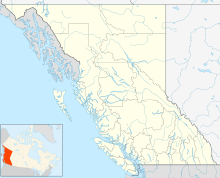Hope Aerodrome
 From Wikipedia - Reading time: 6 min
From Wikipedia - Reading time: 6 min
Hope Aerodrome | |||||||||||
|---|---|---|---|---|---|---|---|---|---|---|---|
| Summary | |||||||||||
| Airport type | Public | ||||||||||
| Operator | Fraser Valley Regional District | ||||||||||
| Location | Hope, British Columbia | ||||||||||
| Time zone | PST (UTC−08:00) | ||||||||||
| • Summer (DST) | PDT (UTC−07:00) | ||||||||||
| Elevation AMSL | 128 ft / 39 m | ||||||||||
| Coordinates | 49°22′06″N 121°29′53″W / 49.36833°N 121.49806°W | ||||||||||
| Map | |||||||||||
 | |||||||||||
| Runways | |||||||||||
| |||||||||||
Hope Aerodrome (IATA: YHE, ICAO: CYHE) is located 2.6 nautical miles (4.8 km; 3.0 mi) west of Hope Townsite[3] (the previous Town of Hope) within the municipal District of Hope, British Columbia, Canada.
The airfield is home to the Vancouver Soaring Association, a gliding club owning and operating seven school and recreational sailplanes and two Cessna L-19 Bird Dog as tow planes.
There is one turf runway, 3,960 ft × 250 ft (1,207 m × 76 m). The airport is operated by the Fraser Valley Regional District. The Hope Airport lies within the community of Flood in the District of Hope.[4]
History
[edit]In approximately 1942 the aerodrome was listed as RCAF & D of T Aerodrome - Hope, British Columbia at 49°22′N 121°29′W / 49.367°N 121.483°W with a variation of 23 degrees 40' east and elevation of 117 ft (36 m). The aerodrome was listed as "under construction - servicable" with one runway listed as follows:[5]
| Runway name | Length | Width | Surface |
|---|---|---|---|
| 7/25 | 6,400 ft (2,000 m) | 1,000 ft (300 m) | Turf |
Hope is notable as being the location of a Boeing demonstration of the Boeing 737's landing and take-off abilities in 1972.[6][7]
See also
[edit]References
[edit]- ^ Canada Flight Supplement. Effective 0901Z 16 July 2020 to 0901Z 10 September 2020.
- ^ Synoptic/Metstat Station Information Archived 2013-06-27 at the Wayback Machine
- ^ District of Hope name for the area of the previous town of hope see district website - www.hope.ca/upload/dcd597_Hope_Townsite_ROADMAP.pdf
- ^ Map of the District of Hope, see district website file - www.hope.ca/upload/dcd600_frvd_area_hope.pdf on map webpage www.hope.ca/bylaws/index.php?SUID=&selectedFolder=84
- ^ Staff writer (c. 1942). Pilots Handbook of Aerodromes and Seaplane Bases Vol. 2. Royal Canadian Air Force. p. 139.
- ^ https://www.youtube.com/watch?v=aOpBXmqa0eY 737 Landing at CYHE in 1972
- ^ Catchpole, Dan (March 26, 2016). "Almost cancelled, the Boeing 737 has endured 49 years". The Daily Herald. Retrieved September 4, 2017.
External links
[edit]- Vancouver Soaring Association
- Hope Airport Weather Cam at Nav Canada's WxCam Service
- Hope Airpark on COPA's Places to Fly airport directory
- Accident history for YHE: Hope Airport at Aviation Safety Network
- Past three hours METARs, SPECI and current TAFs for Hope Airport from Nav Canada as available.
 KSF
KSF
